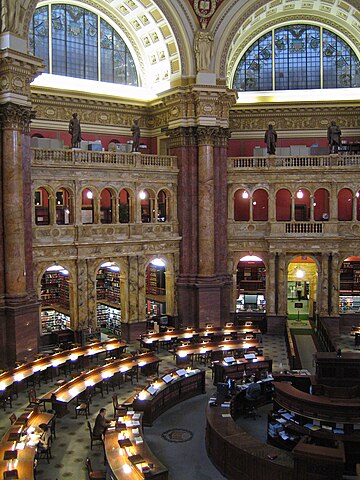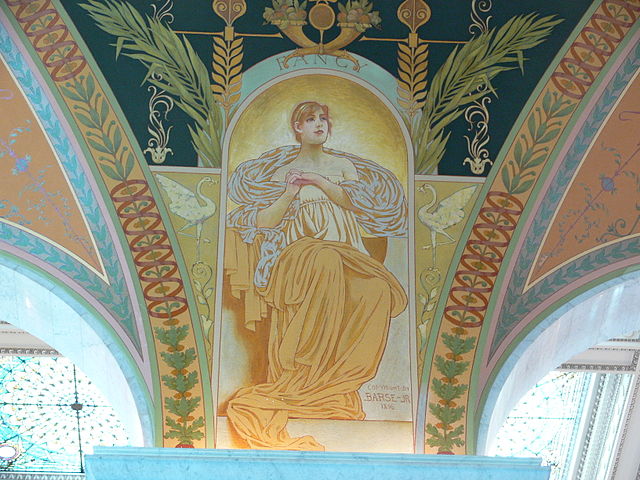The Library of Congress, Washington, D.C., U.S.A.

The Library of Congress in Washington, D.C., has over 36 million catalogued books and other printed material, 3.5 million recordings, 13.7 million photographs, 5.5 million maps, 6.7 million pieces of sheet music, and 69 million manuscripts, totalling over 158 million items. These are stored on about 838 miles of bookshelves. The Library of Congress, considered the largest library in the world, has an annual budget of just under $600 million USD (almost 20 billion baht). Established in the year 1800, principally to serve the members of the United States and their staff as well as the public, it is a reference library. It has a staff of over 3200 employees. If you have a chance to visit Washington, D. C., it is worth a stop at the library’s older structures, especially the Thomas Jefferson Building, completed in 1897.
It is appropriate that a building at the Library of Congress should be named after Jefferson, since at one dramatic moment in history, Jefferson’s own personal library became an essential part of its collection. In 1814, British troops fighting the War of 1812 burned the Capitol building which contained the Library, destroying its collection. Jefferson, who was living in retirement, felt bad about this loss since he loved books. He offered the Library his own personal book collection to replace that had been lost. Jefferson had carefully assembled his own reference library putting by everything which related to America, and indeed whatever was rare and valuable in every science. The result was generally considered to be one of the finest and most intelligently assembled book collection in America. Since as a longtime politician he was accustomed to controversy and opposition, Jefferson knew he had to explain why people in Congress should want or need books in foreign languages about philosophy, science, and literature, rather than just books about law and politics. Jefferson argued:
I do not know that [my library] contains any branch of science which Congress would wish to exclude from their collection; there is, in fact, no subject to which a Member of Congress may not have occasion to refer.

This Jeffersonian idea of a fine library being based on general knowledge has guided the acquisitions policies of most great libraries worldwide. Although the Library of Congress serves the legislature first, it considers that all subjects are important. In 1815, Jefferson’s own library was purchased by Congress, thereby restoring some of the lost material. Another fire would strike the Library in 1851 and destroy many of these books from Jefferson’s collection.
Many years ago, the building was gilded – covered with a thin layer of gold paint – but this was considered too showy and distracting and allowed to wear off. If you have research to do, entering such a vast and impressive building makes a strong impression. In other parts of the world, especially Europe, library staff may sometimes seem unwelcoming, but the Library of Congress employees are generally friendly and helpful. That may be because the staff is familiar with tourists and researchers from all over the world, many of whom speak much less English than you do.
Always growing.
About 12,000 items are added to the Library of Congress collections every day. Many of these are deposited at the Library as part of the process of registering copyrights, since the Library houses the United States Copyright Office. For over fifty years, the Library of Congress has kept offices overseas to acquire, catalog and preserve materials in places where it would be difficult to obtain them in the usual way books and other printed items are purchased. These offices are located in New Delhi, India; Cairo, Egypt; Rio de Janeiro, Brazil; Jakarta, Indonesia; Nairobi, Kenya; and Islamabad, Pakistan. They acquire items from over 60 countries. The Library of Congress owns materials in 470 languages. Its Asian Division collection has almost three million items, the biggest concentration of Chinese, Japanese and Korean materials outside of Asia. It also has one of the largest Tibetan collections in the world and includes one of the oldest surviving examples of printing, passages from a Buddhist sutra printed in 770 CE. The largest book in its collection measures five feet by seven feet, containing images of Bhutan. The Law Library of Congress alone is the world’s largest law library, with 2.9 million volumes.
Telephone Directories and other unusual items.
Among other collections, the Library also owns over 124,000 telephone books. It has the biggest collection of comic books in the world, with more than 100,000 copies of 5000 different titles. In its newspaper collection, also the world’s most diverse, it owns a newspaper printed in the year 1659.
Digital pioneering and Twitter.
In 2005, the Library declared plans to start a World Digital Library, digitally preserving books and objects from international cultures. In 2010, it announced that it would archive all public communication on Twitter, including all tweets since Twitter began in 2006. In 2010, the Library signed an agreement with the Twitter corporation making this possible. It currently has an ever-increasing archive of about 170 billion tweets. In 2011, the Library was adding 140 million tweets daily to this archive and by the following year the number of daily tweets had grown to about 500 million. The Library is currently organizing and designing this archive before making it available to researchers, although some 400 requests have already been received to consult this collection not yet available to the public.

(all images courtesy of Wikimedia Commons).

